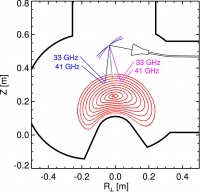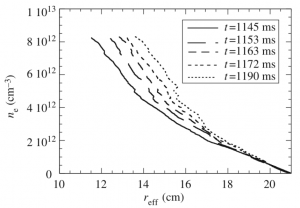TJ-II:Reflectometry: Difference between revisions
| Line 7: | Line 7: | ||
for measuring electron density profiles with a temporal resolution of 2 ms. | for measuring electron density profiles with a temporal resolution of 2 ms. | ||
Separate antennas are used for launching and receiving the signal. The antennas are located in the equatorial plane of the toroidal cross-section at φ = 45º (between [[TJ-II:Sectors|sectors]] A4 and A5), and view the plasma from the low-field side. | Separate antennas are used for launching and receiving the signal. The antennas are located in the equatorial plane of the toroidal cross-section at φ = 45º (between [[TJ-II:Sectors|sectors]] A4 and A5), and view the plasma from the low-field side. | ||
Inside the vacuum vessel, a fundamental wave-guide is used to transmit the signal from the closest port (A4top: φ =38.17º, θ =90º) to the desired launching location (φ = 45º,θ = 180º). | Inside the vacuum vessel, a fundamental wave-guide is used to transmit the signal from the closest port (A4top: φ = 38.17º, θ = 90º) to the desired launching location (φ = 45º, θ = 180º). | ||
== Fluctuation Reflectometer == | == Fluctuation Reflectometer == | ||
Revision as of 09:43, 9 August 2009
Profile Reflectometer
TJ-II has an AM reflectometer [1] for measuring electron density profiles with a temporal resolution of 2 ms. Separate antennas are used for launching and receiving the signal. The antennas are located in the equatorial plane of the toroidal cross-section at φ = 45º (between sectors A4 and A5), and view the plasma from the low-field side. Inside the vacuum vessel, a fundamental wave-guide is used to transmit the signal from the closest port (A4top: φ = 38.17º, θ = 90º) to the desired launching location (φ = 45º, θ = 180º).
Fluctuation Reflectometer
A fast frequency hopping reflectometer [2] working in the Q-band (33 - 50 GHz) was used from 2004 - 2008 in sector B8 in perpendicular incidence (conventional reflectometry). The system allowed studies of the velocity shear layer in TJ-II [3] and of the radial position of its origin. [4]
Doppler Reflectometer

Since February 2009, the frequency hopping system is in operation in oblique incidence (Doppler reflectometry, sector C6) [5] , measuring plasma density fluctuation velocities and their wave number spectra. The system is able to measure in a radial range of about ρ = 0.6 - 0.9 (ρ = r/a is the effective plasma radius) and the perpendicular wavenumber can be selected between 3 and 15 cm-1.
The system consists of a circular choked-corrugated antenna [6] (fabricated by the Antenna Group of the Public University of Navarra, Spain) which emits a microwave beam with a gaussian electric field distribution. The beam is reflected by a steerable ellipsoidal mirror to the plasma. The mirror serves for two purposes: 1) focus the microwave beam to the region where backscattering takes place and 2) change the angle of incidence between beam and plasma, giving the possibility to select the turbulence scale to be measured.
References
- ↑ T. Estrada et al., Plasma Phys. Control. Fusion 43 (2001) 1535–1545
- ↑ L. Cupido, J. Sánchez and T. Estrada, Rev. Sci. Intrum. 75 (2004) 3865
- ↑ T. Estrada, E. Blanco, L. Cupido, M.E. Manso, and J. Sánchez, Nucl. Fusion 46 (2006) S792–S798
- ↑ T. Happel, T. Estrada, and C. Hidalgo, Europhys. Lett. 84 (2008) 65001
- ↑ T. Happel, T. Estrada, E. Blanco, V. Tribaldos, A. Cappa, and A. Bustos, Rev. Sci. Instrum. 80 (2009) 073502
- ↑ J. Teniente, R. Gonzalo, and C. del-Rio, IEEE Antennas Wireless Propag. Lett. 5 (2006) 380
